Valuing Chocolate Diamonds: Trends and Insights
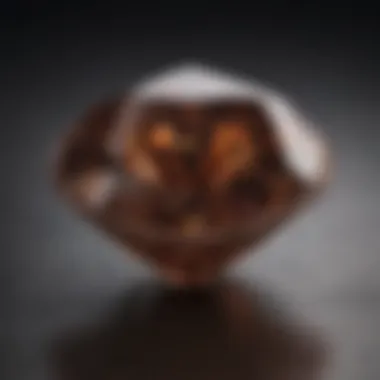
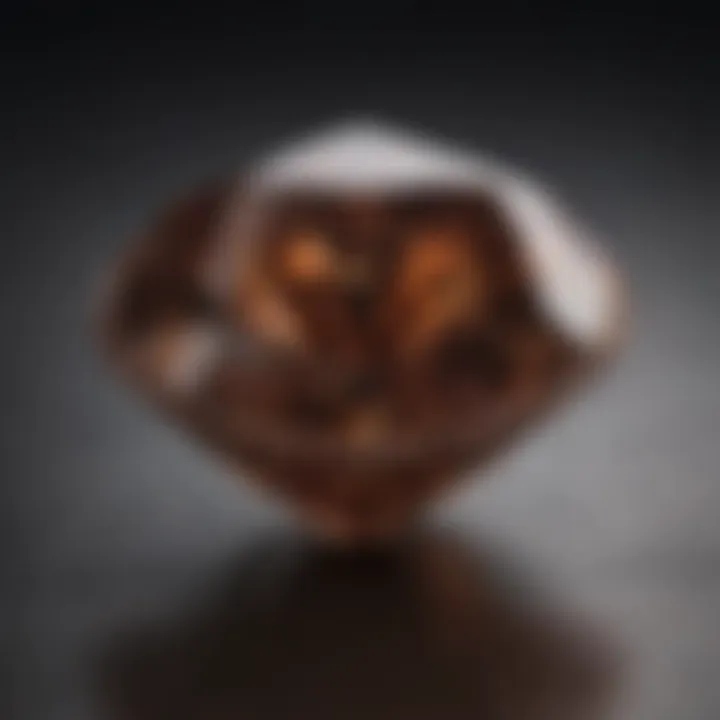
Intro
The world of gemstones is as intricate as a spider's web, with countless threads representing the various facets of these natural marvels. Among these precious creations, chocolate diamonds have emerged as an intriguing option for collectors and jewelry designers alike. Their rich, warm tones beckon those with an appreciation for the unique, yet they also raise questions about their market position and intrinsic value.
Gemstone Overview
Definition and Characteristics
Chocolate diamonds, scientifically recognized as brown diamonds, exhibit a strong hue that ranges from light brown to deep, dark shades. Unlike traditional colorless diamonds which sparkle with a clear brilliance, chocolate diamonds have a unique allure due to their earthy tones. Color is assigned based on a grading system that considers nuances such as hue, tone, and saturation.
- Hue: Refers to the actual color, which ranges from light brown to nearly black.
- Tone: The lightness or darkness of the color.
- Saturation: The purity and intensity of the color.
These diamonds also display certain physical characteristics such as high durability, which makes them suitable for everyday wear. This durability adds to their appeal among designers who seek both beauty and practicality in their creations.
Classification of Gemstones
Gemstones can generally be categorized based on their composition and formation. Brown diamonds fall under the category of diamond gemstones, a group that includes both colorless and colored variations. They are classified further by their color and optical properties. In this classification, chocolate diamonds have sparked a fascination of their own, often being grouped with fancy color diamonds due to their specific tonal quality.
Chocolate diamonds offer something a little different, a touch of warmth compared to the cooler tones of traditional diamonds. This warmth is likely one reason why they have become a desirable choice for many looking for something that strays from the mainstream.
Historical Significance
Ancient Uses and Cultural Importance
Throughout history, gems have wielded significant power, not just as adornments but as symbols of status and influence. Brown diamonds have long been sought after, but their appreciation has waxed and waned over time. Initially, they were not as valued as their colorless counterparts, often seen as inferior. It was only in recent decades that their value began to shift—a change driven by evolving tastes in fashion and jewelry.
In some cultures, gemstones are thought to hold protective energies or mystical qualities. While chocolate diamonds may not have the weighty myths surrounding sapphires or rubies, they still occupy a niche where personal significance and history intertwine.
Myths and Legends Surrounding Gemstones
For centuries, gemstones have been enveloped in tales of fortune, love, and power. Diamonds, including chocolate variations, have been associated with love and commitment, finding their way into rings and heirlooms. The deeper, richer colors have sometimes been thought to represent earthiness and stability, appealing especially to those who relate to the strength of these traits.
"The worth of a diamond may be measured not by its price tag, but by the stories it carries and the memories it creates."
In summary, understanding chocolate diamonds is a journey through their unique characteristics, historical context, and cultural significance. This exploration sets the stage for further discussion on how their worth is assessed and recognized within the marketplace. The confluence of appealing aesthetics, historical depth, and market dynamics provides collectors and enthusiasts with a comprehensive view of this fascinating gemstone.
Foreword to Chocolate Diamonds
Chocolate diamonds, a term that has become more common in recent years, are captivating gemstones that have drawn the attention of collectors, jewelers, and gemstone enthusiasts alike. These particular diamonds, notable for their distinct brown hue, have prompted a conversation not only about their aesthetic appeal but also about their intrinsic value. As the world of luxury jewelry continues to evolve, understanding chocolate diamonds has emerged as a significant part of that discourse. In this article, we explore why chocolate diamonds are worthy of consideration, diving deep into their characteristics, market presence, and factors that influence their price.
Defining Chocolate Diamonds
At its core, a chocolate diamond is simply a fancy brown diamond with a rich, warm coloration that resembles the color of chocolate. Unlike traditional white diamonds, which may convey a sense of purity and clarity, chocolate diamonds boast a complexity that can be both striking and alluring. Their unique brown shades can range from light caramel to a deep, rich chocolate, making them versatile for various types of jewelry.
In terms of grading, these diamonds fall under the category of fancy color diamonds. The hue, tone, and saturation play crucial roles in determining their quality. For example, darker and richer tones are generally more prized than lighter shades. The color grading system, used by gemological laboratories, is essential in understanding the worth of a chocolate diamond. It is important to realize that while chocolate diamonds may not rank among the traditional top-tier gemstones, their unique properties allow them to carve out their own niche in the market.
The Rise in Popularity
Over recent years, there has been a notable surge in the popularity of chocolate diamonds, an evolution driven by several factors. Celebrity endorsements and novel marketing strategies have brought these gems to the forefront of the jewelry world. High-profile figures flaunting chocolate diamonds in various events have stirred interest and curiosity among the general populace. But beyond celebrity culture, there's also a growing appreciation for colored stones in general, as consumers seek individuality and symbolism in their jewelry selections.
Moreover, chocolate diamonds have resonated with those looking for an alternative to conventional diamond options. Couples, in particular, favor them for engagement rings, seeking something unconventional to signify their love. This trend has not only influenced consumer preferences but also transformed the marketing strategies of jewelry brands. Companies are positioning chocolate diamonds as an eco-friendly and unique choice, which further boosts their attraction.
"The rise of chocolate diamonds highlights the changing landscape of the jewelry market, where consumer taste drives innovation and diversity."
The Composition of Chocolate Diamonds
Understanding the composition of chocolate diamonds is crucial for grasping what makes these gems unique. Their distinct coloration, often described as resembling rich, dark chocolate, is due to specific impurities and structural anomalies within the diamond's carbon lattice. Unlike traditional clear diamonds, which are primarily valued for their optical purity and brilliance, chocolate diamonds derive their worth from a more complex interplay of factors, reflecting both their beauty and rarity.
Scientific Properties of Brown Diamonds
Brown diamonds, or chocolate diamonds as they're often affectionately known, contain varying amounts of nitrogen that play a significant role in their coloration. These diamonds are classified under the category of type I diamonds, which are known for having nitrogen impurities. The way in which these impurities are distributed affects the color intensity. The deeper the color, the more nitrogen is present, which can create stunning visual effects when light passes through.
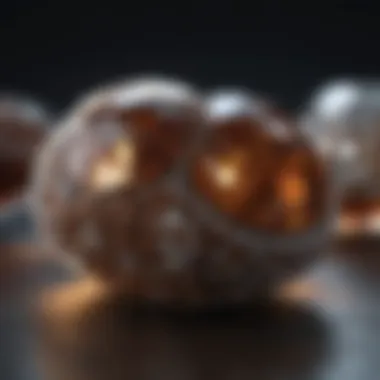

Additionally, the crystal structure of chocolate diamonds can influence their appearance. The presence of radiation during the formation process can create a secondary change in color, resulting in the rich brown hues that are so sought after. It's interesting to note that the grading of these diamonds involves assessing not just the color, but also their clarity and the way they reflect light. This makes chocolate diamonds an intriguing study in how unique geological processes can yield something that’s not only a gemstone but also a conversation starter.
"Investing in chocolate diamonds is like sipping on a fine wine; the more you know, the better it gets."
Natural vs. Synthetic Origins
The origins of chocolate diamonds can be divided into two main categories: natural and synthetic. Natural chocolate diamonds are formed deep within the earth under intense pressure and heat over millions of years. They are valued not only for their beauty but also for their geological history. These diamonds embody a sense of timelessness, as they have journeyed through the depths of the earth to reach us.
On the flip side, synthetic chocolate diamonds, created in controlled environments through processes like High Pressure High Temperature (HPHT) or Chemical Vapor Deposition (CVD), have gained traction in recent years. They can mimic the color and clarity of natural brown diamonds closely. However, their market positioning is significantly different. While they may present a more affordable option for consumers, many collectors and enthusiasts still gravitate towards the allure of natural stones due to their unique provenance.
Both origins raise intriguing questions regarding value. Natural diamonds typically command a higher price due to their scarcity and natural allure. Meanwhile, synthetic options offer a newer avenue for potential buyers looking for affordability without sacrificing beauty, though they often lack the same investment potential as their natural counterparts.
Factors Influencing the Worth
Determining the worth of chocolate diamonds is no straightforward calculation. It’s a delicate dance of various elements, all competing for the spotlight. This section explores the specific characteristics that mold the market value of these unique gemstones, focusing on the crucial aspects of color grading, clarity, cut quality, and carat weight.
Color Grading and Its Impact
Color grading serves as a cornerstone in the valuation of chocolate diamonds. Unlike traditional diamonds, which are often sought for their lack of color—attributed to the D-Z grading scale—chocolate diamonds have a distinct spectrum of lovely brown hues. Their grading system falls into the realm of the Fancy Color Scale, ranging from light champagne to deep cognac hues.
The intensity and tone of color play pivotal roles. A deeper, richer hue often translates to a higher price tag, as it suggests rarity and desirability. Conversely, a lighter shade may fetch less on the open market. Jewelry buyers need to recognize that while all shades have their charm, certain colors can significantly amplify a diamond's worth. To better understand this, consider the following:
- Deep Chocolate Brown: Generally considered the highest value.
- Champagne Shades: Often popular, but mid-value.
- Light Brown: Tends to hold lesser worth due to abundance.
Clarity and Cut Quality
When discussing clarity, it’s crucial to remember that imperfections—such as inclusions and blemishes—are not just trivial details; they can significantly impact a chocolate diamond’s desirability.
The clarity grading system ranges from Flawless (no inclusions visible even under magnification) to Included (inclusions visible to the naked eye). Generally, consumers aim for diamonds that are graded between VS (Very Slightly Included) and SI (Slightly Included) as these offer a balance between beauty and value. A transparent chocolate diamond, free from visible imperfections, can command higher prices.
Equally important is the cut quality. The better the cut, the more a diamond sparkles and shines, drawing the eye. A well-cut diamond enhances the depth of color and increases brilliance, making the stone more appealing. Thus, valuing clarity alongside cut is essential in understanding the worth.
Carat Weight Considerations
Carat weight is perhaps one of the most quantifiable aspects when determining a chocolate diamond’s value. Larger stones are often perceived as more valuable. However, it’s not merely about size; the perceived value of carat weight also rides on the combined factors of color, clarity, and cut quality.
For instance, a smaller chocolate diamond that possesses exquisite color and clarity might outshine a larger stone with lower quality in the eyes of discerning collectors. It’s wise for buyers to remember that the best value isn’t always found in size alone; it’s often a harmonious blend of size and quality that defines a chocolate diamond's true worth.
"The worth of chocolate diamonds isn't just about size; it's an intricate balance of color, clarity, and cut that shapes their value in the market."
In summary, understanding these elements—color grading, clarity, cut quality, and carat weight—helps gemstone enthusiasts, collectors, and jewelry designers gauge the real worth of chocolate diamonds, paving the way for informed decisions in this captivating market.
Current Market Trends
Understanding current market trends is essential for anyone interested in the world of chocolate diamonds. The jewelry market is fluid and ever-changing, influenced by various factors such as consumer preferences, brand positioning, and economic conditions. Analyzing these trends can provide insights into how chocolate diamonds fit into the larger landscape of luxury jewelry. Specifically, while appreciation for these unique gemstones grows, it becomes crucial to evaluate how they stand against other jewelry options, and how their worth is perceived in the market.
Demand Dynamics in Luxury Jewelry
Consumer demand for luxury items, including chocolate diamonds, has shown remarkable resilience even during tougher economic times. This could be attributed to buyers increasingly viewing luxury jewelry not merely as a status symbol but as an investment. Chocolate diamonds' distinctive hue sets them apart in the crowded gemstone market, appealing to those who value uniqueness and options beyond traditional diamonds.
Factors driving the demand for chocolate diamonds include:
- Artistic Appeal: Many consumers are drawn to the rich, earthy tones that chocolate diamonds offer, which may pair beautifully with various metals and designs.
- Brand Influence: Certain brands specialize in these gems, boosting their appeal through strategic marketing and luxury branding. For instance, companies like LeVian have cultivated a niche that highlights the unique properties of chocolate diamonds.
Such dynamics suggest that chocolate diamonds are not just a passing fad but a growing segment of luxury jewelry that caters to a discerning clientele. As consumers seek pieces that reflect individual aesthetics, chocolate diamonds fit the bill alluringly.
Investment Potential of Chocolate Diamonds
Investing in chocolate diamonds might seem like a gamble at first glance. However, an increasing number of enthusiasts and collectors are now considering them a viable alternative to traditional investments like stocks or bonds. The perceived rarity of high-quality chocolate diamonds can lead to significant appreciation in value over time.
A few key points regarding their investment potential include:


- Limited Supply: The natural occurrence of brown diamonds is less frequent compared to classic white diamonds, causing their value to appreciate more robustly.
- Market Recognition: As the market becomes more educated about chocolate diamonds, their recognition as a legitimate investment option grows. Many experts predict that certain stones will command prices comparable to traditional colored gems, enhancing their attractiveness to investors.
- Collector Interest: With the rise of social media platforms and online forums, more collectors are gathering to discuss and trade chocolate diamonds. This community fosters enthusiasm and can drive demand for specific varieties, especially those with remarkable characteristics.
In summary, current market trends point towards a bright outlook for chocolate diamonds. Both their appeal in luxury jewelry and their potential as an investment make them noteworthy players in today's gemstone market. Through a thorough understanding of these dynamics, enthusiasts can better navigate this fascinating and evolving landscape.
Valuation Techniques for Chocolate Diamonds
When it comes to assessing the worth of chocolate diamonds, valuation techniques play a crucial role. They provide a framework for determining the intrinsic value of these unique gemstones. Considering the growing interest in chocolate diamonds, understanding these valuation methods can empower potential buyers, collectors, and industry professionals alike.
Key Elements of Valuation Techniques:
- Establishing accurate benchmarks based on market history
- Taking into account gem color, clarity, cut, and carat weight
- Identifying reliable sources and professionals for evaluations
- Considering external factors like branding and market demand
Utilizing effective valuation techniques not only aids in price determination, but also enhances informed purchasing decisions. An accurate appraisal can have a significant impact on investment potential in chocolate diamonds, guiding clientele towards products that resonate with their preferences and financial priorities.
Professional Appraisals
Professional appraisals are often deemed the gold standard when valuing chocolate diamonds. These evaluations are conducted by certified gemologists who employ an in-depth approach to determine various aspects of a diamond's worth. For instance, these experts analyze characteristics such as:
- Color Intensity: The richness and warmth of the chocolate hue can greatly influence price.
- Clarity: A thorough understanding of any inclusions or blemishes is pivotal in establishing quality.
- Cut Quality: A well-cut chocolate diamond will reflect light attractively, enhancing its visual appeal.
- Carat Weight: Size often speaks volumes in the market; larger diamonds typically command higher prices.
Engaging a professional typically guarantees a more reliable appraisal. However, one should be mindful to choose qualified gemologists who have experience specifically with brown diamonds, as nuances in this category can differ from traditional diamonds.
DIY Valuation Methods
For those who wish to step into the world of chocolate diamonds without incurring the costs of professional services, there are DIY valuation methods. Though these approaches offer a less precise outcome than certified evaluations, they can provide potential buyers with a foundational understanding of a diamond's value:
- Researching Market Prices: Look at recent sales data and market listings for similar chocolate diamonds. Websites like en.wikipedia.org or reddit.com can provide valuable insight on current trends and pricing.
- Using Color and Clarity Charts: Several online resources offer color and clarity grading charts specifically for brown diamonds. Familiarizing oneself with these charts can help buyers gauge their stone's attributes better.
- Weight Estimation Tools: DIY scales can give reasonable approximations of carat weight, important for initial valuation but not a substitute for proper methods.
Remember, while DIY methods can be educational and fun, they may not reflect the true value of a chocolate diamond. For accurate and marketable appraisals, consulting with a professional remains the recommended course of action. Through effective valuation, whether professional or DIY, enthusiasts can navigate the chocolate diamond market with increased confidence, ensuring they make informed choices.
Comparison with Other Gemstones
When talking about gemstones, it's vital to understand how chocolate diamonds stack up against their counterparts. This comparison sheds light on their unique worth, market viability, and consumer preferences. Knowing these nuances can help collectors and enthusiasts make informed choices when investing in or appraising not just chocolate diamonds but also other gems.
Chocolate Diamonds vs. Traditional Diamonds
Chocolate diamonds, or brown diamonds, have carved out a niche somewhat distinct from traditional clear or white diamonds. While the latter have long been revered as the quintessential jewel signifying luxury, the former brings its own distinct charm and broader palette of colors to the table.
One primary difference lies in their grading criteria. Traditional diamonds are usually assessed based on the well-known Four Cs: carat weight, clarity, color, and cut. Chocolate diamonds, however, introduce an extra layer of complexity when it comes to color grading. They are often classified based on their intensity of brown hues, ranging from light to fancy deep shades, which can dramatically affect their price and desirability.
In terms of price, traditional diamonds, particularly the larger and clearer ones, can command astronomical figures at auctions. On the other hand, chocolate diamonds generally price more modestly, making them an accessible option for those wanting to indulge in gemstone ownership without breaking the bank. It's akin to buying an art piece; while some may invest in a renowned painting with a hefty price tag, others might find beauty and investment potential in a vibrant local artist’s work.
Another point of interest is cultural perception. Traditionally, a clear diamond often carries a weight of social prestige. Despite this, chocolate diamonds are steadily gaining traction. They resonate with those who appreciate uniqueness and a different aesthetic.
Ultimately, chocolate diamonds challenge the prevailing views of what constitutes a luxurious jewel. Their earthy tones and rich depths invite wearers to be more discerning and appreciate beauty in diversions from the norm.
Market Position Against Other Colored Gems
When juxtaposing chocolate diamonds with other colored gems like sapphires, rubies, and emeralds, the dynamics shift yet again. Each colored gemstone brings something distinct to the market. However, chocolate diamonds enjoy a unique plank in this colorful spectrum.
Unlike the well-known sapphires which often dominate discussions of color stones, or the fiery allure of rubies, chocolate diamonds often play in complexity. Their subtlety often gets overshadowed. Yet, enthusiasts appreciate their uniqueness and earthy tones, granting them an edge in niche markets, especially amongst collectors who desire to diversify their gemstone portfolios.
Consumer preferences tend to shift with trends. For instance, vibrant colors like blue or green can draw immediate attention, whereas chocolate diamonds tend to cultivate an appreciation that grows over time. They evoke sentiments of warmth and safety, often appealing to those who resonate with a more natural aesthetic.
Ultimately, while chocolate diamonds might not steal the limelight like their more flamboyant counterparts, they certainly hold their ground in terms of collectibility and investment potential. As markets evolve, they are increasingly being recognized not just as a secondary option but a worthy investment in their own right.
"The worth of a gemstone often lies not solely in its color or clarity but in the story and emotional connection it establishes with its beholder."
Understanding the positioning of chocolate diamonds within this gem hierarchy provides an enriching perspective for those looking to delve into the world of colored gems. This exploration emphasizes the importance of nuance, personal taste, and market trends when evaluating gemstone worth.
The Role of Branding in Chocolate Diamond Worth
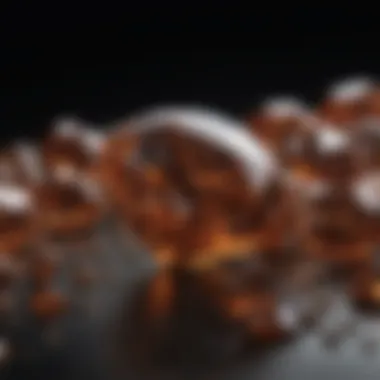
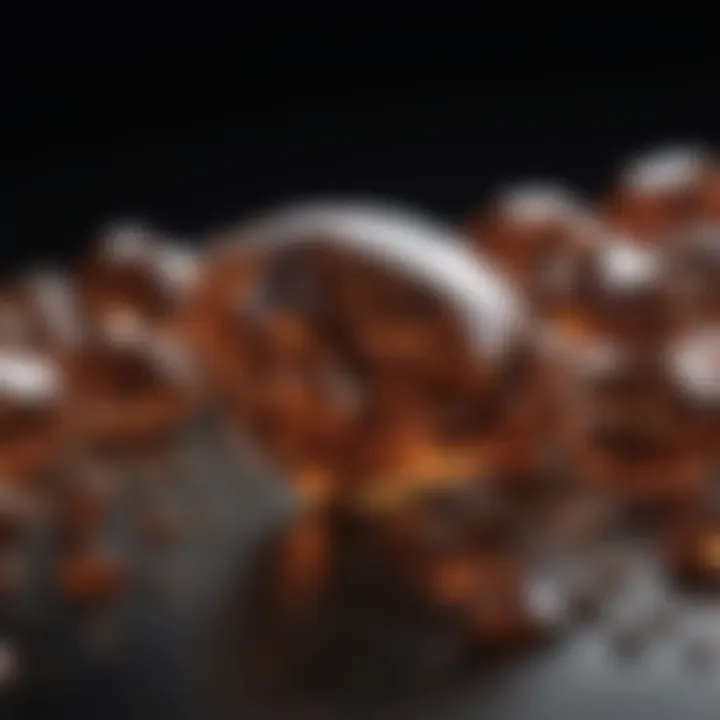
When it comes to chocolate diamonds, branding plays a vital role that goes beyond mere aesthetics. In a marketplace crowded with choices, brand recognition can be the tipping point for buyers. It sets the stage for consumer expectations and can greatly influence perceived value. A well-established brand not only garners trust but also adds a narrative that makes the purchase feel special and meaningful.
Impact of Brand Recognition
Brand recognition isn’t just a warm, fuzzy feeling. It has tangible effects on the valuation of chocolate diamonds. Take, for instance, the feeling of stepping into a high-end jewelry store versus a corner shop. The atmosphere, the staff, and the brand’s reputation all inform your perception of worth.
Brands like Le Vian, known for their unique chocolate diamond offerings, leverage their reputation to command higher prices. Customers are willing to pay a premium because they associate the brand with quality, elegance, and exclusivity. It is the story behind the brand that sells the product; consumers are not merely buying a gemstone but an experience that includes prestige and a sense of belonging to an elite group.
Listed below are some key effects of brand recognition:
- Trust and Loyalty: Once consumers buy from a brand and have a positive experience, they are likely to return. This loyalty can translate into higher future sales, thereby solidifying the worth of those chocolate diamonds.
- Perceived Quality: An established brand usually symbolizes higher quality. This leads to a perception that their chocolate diamonds are superior, thus enhancing value.
- Market Differentiation: In a saturated market, branding can help chocolate diamonds stand out from the competition. It allows for stories, heritage, and crafting techniques to be shared, creating a unique identity around the jewels.
Marketing Strategies in the Gem Industry
The marketing strategies employed in the gem industry, particularly for chocolate diamonds, are unique and intricate. It’s about more than just flashy advertisements; it's about creating a lasting impression in consumers' minds.
- Storytelling: Tell the story of chocolate diamonds, focusing on their origin, cut, and the careful craftsmanship involved in their creation. For instance, showcasing the unique journey of acquiring a rare brown diamond can entice customers.
- Social Proof: Utilize endorsements from celebrities or influencers who advocate for chocolate diamonds. Their recommendations can validate quality and desirability in the eyes of consumers.
- Community Engagement: Brands increasingly engage with communities through social media platforms such as Facebook and Reddit. They can cultivate communities of enthusiasts and collectors who share tips, experiences, and even organize events.
- Sustainability: Highlight ethical sourcing and environmentally-friendly practices. Today's consumer often makes choices based on values. Transparency in the supply chain can significantly enhance a brand's appeal.
- Exclusivity and Limited Editions: Rolling out exclusive pieces or limited editions can create a buzz. The fear of missing out often compels consumers to make purchases they wouldn’t typically consider.
In the realm of chocolate diamonds, a brand isn’t just a logo; it’s the heartbeat of consumer connection and value perception.
By leveraging these strategies, brands not only enhance the perceived value of chocolate diamonds but also ensure that consumers feel part of something larger than themselves. Thus, the branding exercise in the gem industry is not merely about selling jewelry; it's about crafting legacies and building trustworthiness that resonate through generations.
Consumer Perspectives
In examining chocolate diamonds, one must not overlook the lens of consumer perspectives. These gemstones, with their rich color ranging from light brown to deep, dark chocolate, are not just about aesthetics; they're also about the emotional and financial investment buyers are willing to make. Understanding consumer perspectives can shed light on market trends, perceived value, and overall demand.
One key element involves discerning buying trends among collectors. Many collectors are drawn to the uniqueness of chocolate diamonds compared to traditional white diamonds. The rarity and distinctiveness of brown diamonds can create a certain allure. As these collectors delve deeper into the gem market, they often prioritize gemstones that stand out and tell a story. It’s somewhat like finding a hidden gem in a thrift shop—there’s a thrill in uncovering something that echoes one’s tastes and preferences.
Buying Trends Among Collectors
The buying trends present an intricate tapestry of preferences and motivations for collectors of chocolate diamonds. Factors influencing these trends include:
- Individuality: Many collectors seek items that reflect their personal style rather than what's mainstream. Chocolate diamonds’ earthy tones allow for a broader range of jewelry designs, appealing to those wanting something outside the conventional.
- Perceived Value: Collectors often gauge value based on rarity and quality. Chocolate diamonds, particularly those with rich color and clarity, can command prices that might rival more conventional stones.
- Sustainability: Some consumers are also looking at ethical sourcing and sustainable practices in the gemstone industry. Those who appreciate chocolate diamonds may often align with brands that emphasize such practices.
Given these elements, it’s clear that buying trends aren't just shaped by what's flashy or trending at the moment. Rather, they encapsulate deeper emotional connections and aspirational values.
Consumer Education on Value Perception
Education is a fundamental aspect of valuing chocolate diamonds effectively. Most buyers are not gemologists but still want to make informed choices. Here's how consumer education impacts value perception:
- Understanding Quality Grading: Knowing how grading for color, clarity, and cut works can help potential buyers discern when a chocolate diamond is genuinely worth the investment. Being informed can prevent buyers from falling for marketing gimmicks.
- Awareness of Market Fluctuations: Keeping an eye on current market trends provides crucial insights into pricing. For instance, during economic shifts, the luxury segment might perform differently, impacting the worth of chocolate diamonds.
- Connecting Emotionally with Value: Many consumers tend to ascribe value not only on a monetary level but also emotionally. This facet becomes particularly pertinent when considering chocolate diamonds, as many buyers view them as symbols of sentiment or status.
"A diamond is forever, but a chocolate diamond is a personality. It's about standing out rather than fitting in."
In summary, consumer perspectives play a pivotal role in shaping the narrative surrounding chocolate diamonds. Whether examining buying trends or stepping into the realm of value education, these facets emphasize the importance of informed decision-making and highlight how personal attachments can influence market dynamics.
Future Outlook on Chocolate Diamonds
As chocolate diamonds continue to carve their niche in the gemstone market, it becomes essential to speculate on their future trajectory. The popularity of these unique gems has steadily risen, sparking conversations about their long-term valuation and market dynamics. Through examining key trends and potential shifts, we can gain insights into the evolving landscape of chocolate diamonds. This section highlights the importance of understanding not only where these diamonds currently stand but also what the future may hold for collectors and investors alike.
Predicted Market Shifts
The future of chocolate diamonds can often feel like trying to read tea leaves, as many factors converge to shape industry sentiment. Analysts suggest that a shift towards sustainable and ethically-sourced gemstones will increasingly influence consumer behavior. As buyers become more discerning, they are likely to favor chocolate diamonds that emphasize their origin in conflict-free regions.
- Increased environmental awareness may push producers to adopt greener practices.
- The trend toward minimalism in design may also drive demand for natural, raw aesthetic attributes found in chocolate diamonds.
Market forecasts indicate that the premium associated with branded chocolate diamonds could also witness fluctuations. As brands lean into marketing efforts that emphasize the unique characteristics of these stones, their value may see a noticeable increase, creating an arena for competition among jewelers. The authenticity and storytelling behind each piece may become a critical point of differentiation, motivating buyers to invest in these gems.
"The gemstone market is always on the go, changing hands like a game of hot potato. Understanding these dynamics means knowing how to play the long game."
Potential New Trends and Innovations
Innovation doesn't sleep in the realm of gemstones. The future may usher in new technologies aiming to enhance the appeal and marketability of chocolate diamonds. One area poised for growth is the use of advanced imaging techniques to better evaluate the unique color patterns and characteristics of these gems. This can help buyers make well-informed decisions based on precise data regarding the diamond's quality.
Moreover, creating pieces that showcase chocolate diamonds alongside other rare gems could become increasingly popular. Jewelers might experiment with settings and designs that highlight these stones' rich hues, transforming them into statement pieces.
- Lab-grown diamonds might play a role, creating a fascinating dichotomy between natural and synthetic—both in color and consumer preference.
- Collaborations between luxury brands and independent designers may lead to more distinctive offerings centered around chocolate diamonds.
As we look ahead, it’s clear that the landscape for chocolate diamonds is set to evolve. Keeping one's finger on the pulse of these developments will be crucial for stakeholders—from consumers to collectors and industry players.







